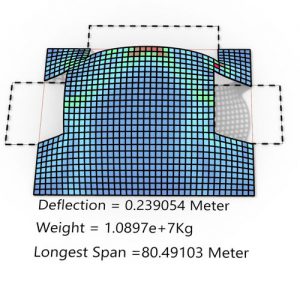In this Grasshopper Millipede tutorial, you can learn how to model a series of smooth connecting columns to a roof and then analyze it using Millipede's Finite Element Analysis.
In this Grasshopper Kangaroo Millipede example file, you can simulate a rectangular concrete shell under pressure with openings.
In this Rhino Grasshopper Kangaroo tutorial, we are going to planarize a series of ngon meshes using the CoPlanar component in the Kangaroo plugin.
In this grasshopper example file, you can design a Gyroid pattern by using the Millipede, Pufferfish and Weaverbird plugins.
In this grasshopper example file by using the Millipede plugin you can model a parametric facade made out of minimal surfaces and Delaunay meshes.
In this grasshopper example file you can capture the sound frequencies and visualize it by using the firefly and millipede plugin.
In this grasshopper example file you can use the Millipede plugin to model a Minimal Surface From a series of parametric curves.
In this Grasshopper definition, you can model a wave-like structure with graph mappers. Then you can use the Millipede plugin to analyze the form. This will give you an overview of which surfaces will give you a better parametric roof structure.
In this grasshopper definition you can use one of the Parakeet's Plugin patterns. First we have transformed the pattern and then used the Millipede plugin to model a minimal surface between the two layers.
In this grasshopper definition you can learn how to use the Millipede's geometry wrapper to model a mesh around a curve and control it with different parameters.
In this grasshopper definition by using the PerlinNoise component of the Noise 4d plugin you can produce a changing value for a iso surface which is generated with Millipede.You can also subdivide the mesh surface to have a smoother result.
In this Grasshopper Definition the isosurface component from the Millipede plugin has been used to create the isosurface mesh. Iso value defines the effective field around each point and merge vertices is set to true to produce smoother mesh around some corners.














